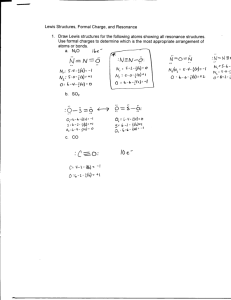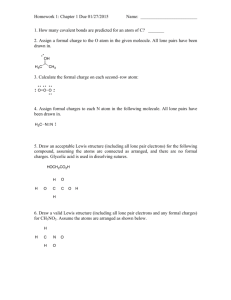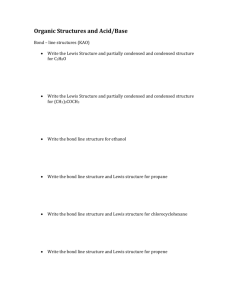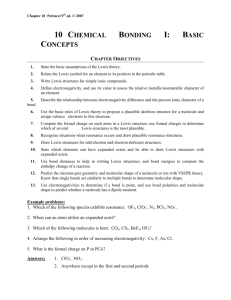Chem 121 Problem Set V Lewis Structures, VSEPR and Polarity
advertisement
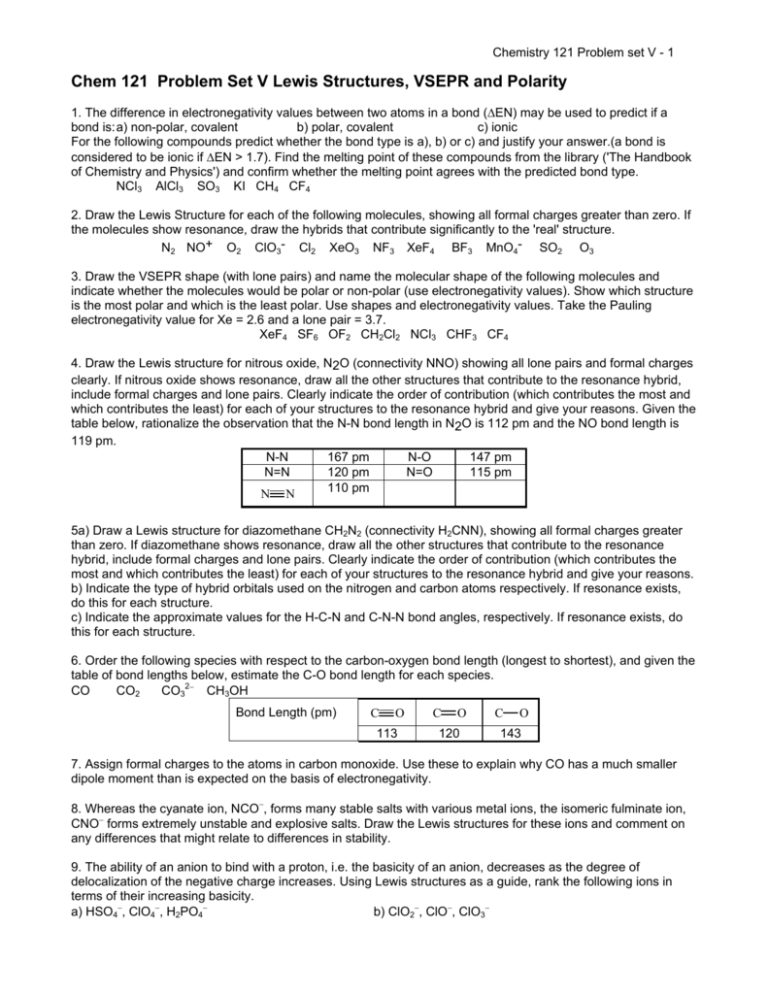
Chemistry 121 Problem set V - 1
Chem 121 Problem Set V Lewis Structures, VSEPR and Polarity
1. The difference in electronegativity values between two atoms in a bond (∆EN) may be used to predict if a
bond is: a) non-polar, covalent
b) polar, covalent
c) ionic
For the following compounds predict whether the bond type is a), b) or c) and justify your answer.(a bond is
considered to be ionic if ∆EN > 1.7). Find the melting point of these compounds from the library ('The Handbook
of Chemistry and Physics') and confirm whether the melting point agrees with the predicted bond type.
NCl3 AlCl3 SO3 KI CH4 CF4
2. Draw the Lewis Structure for each of the following molecules, showing all formal charges greater than zero. If
the molecules show resonance, draw the hybrids that contribute significantly to the 'real' structure.
N2 NO+ O2 ClO3- Cl2 XeO3 NF3 XeF4 BF3 MnO4- SO2 O3
3. Draw the VSEPR shape (with lone pairs) and name the molecular shape of the following molecules and
indicate whether the molecules would be polar or non-polar (use electronegativity values). Show which structure
is the most polar and which is the least polar. Use shapes and electronegativity values. Take the Pauling
electronegativity value for Xe = 2.6 and a lone pair = 3.7.
XeF4 SF6 OF2 CH2Cl2 NCl3 CHF3 CF4
4. Draw the Lewis structure for nitrous oxide, N2O (connectivity NNO) showing all lone pairs and formal charges
clearly. If nitrous oxide shows resonance, draw all the other structures that contribute to the resonance hybrid,
include formal charges and lone pairs. Clearly indicate the order of contribution (which contributes the most and
which contributes the least) for each of your structures to the resonance hybrid and give your reasons. Given the
table below, rationalize the observation that the N-N bond length in N2O is 112 pm and the NO bond length is
119 pm.
N-N
167 pm
N-O
147 pm
N=N
120 pm
N=O
115 pm
110
pm
N N
5a) Draw a Lewis structure for diazomethane CH2N2 (connectivity H2CNN), showing all formal charges greater
than zero. If diazomethane shows resonance, draw all the other structures that contribute to the resonance
hybrid, include formal charges and lone pairs. Clearly indicate the order of contribution (which contributes the
most and which contributes the least) for each of your structures to the resonance hybrid and give your reasons.
b) Indicate the type of hybrid orbitals used on the nitrogen and carbon atoms respectively. If resonance exists,
do this for each structure.
c) Indicate the approximate values for the H-C-N and C-N-N bond angles, respectively. If resonance exists, do
this for each structure.
6. Order the following species with respect to the carbon-oxygen bond length (longest to shortest), and given the
table of bond lengths below, estimate the C-O bond length for each species.
CO
CO2
CO32− CH3OH
Bond Length (pm)
C
O
113
C
O
120
C
O
143
7. Assign formal charges to the atoms in carbon monoxide. Use these to explain why CO has a much smaller
dipole moment than is expected on the basis of electronegativity.
8. Whereas the cyanate ion, NCO−, forms many stable salts with various metal ions, the isomeric fulminate ion,
CNO− forms extremely unstable and explosive salts. Draw the Lewis structures for these ions and comment on
any differences that might relate to differences in stability.
9. The ability of an anion to bind with a proton, i.e. the basicity of an anion, decreases as the degree of
delocalization of the negative charge increases. Using Lewis structures as a guide, rank the following ions in
terms of their increasing basicity.
a) HSO4−, ClO4−, H2PO4−
b) ClO2−, ClO−, ClO3−
Chemistry 121 Problem set V - 2
10. Of the following compounds of sulfur, which, if any, do not possess a permanent dipole. Take the Pauling
electronegativity value for a lone pair = 3.7.
SF2
SF3+
SF3−
SF4
SF5+
SF5−
SF6
11. Give the formula of compounds or ions formed only from iodine and fluorine that have the following
structures
a) Square planar
b) Pyramidal
c) T-shaped
d) Linear
e) Square pyramidal
f) Octahedral
12. Give the formulae of all binary compounds and ions containing antimony and fluorine, SbFn(−,0,+) that do not
possess a permanent dipole. Take the Pauling electronegativity value for a lone pair = 3.7.
13. Choose elements in order to give examples of two neutral species XFn such that in one species all adjacent
F-X-F angles are exactly 90° and in the other species they are slightly less than 90° (from Chem 111 Final
1995).
14. Choose an element in order to give an example of a neutral species XF4 that possess a permanent dipole.
